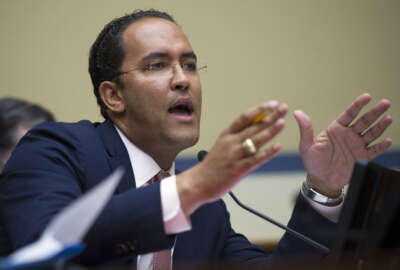
Congress wants to know if 18F, Digital Service will take on legacy IT
Two years after the administration set up two new federal "start-ups" to help agencies adopt more innovative technology, some in the public and private sectors say...
Roughly two years after the administration established the U.S. Digital Service and the General Services Administration’s 18F as a way to spark more innovation in the IT space, some in the public and private sector still see the two federal “start-ups” as slightly foreign entities.
Both agency and industry IT leaders say they’re looking for more insight into the kinds of projects 18F and USDS take on, and they want more communication from both organizations as they embark on an approach to IT procurement and development that the rest of government has been slow to adopt.
“The start-up mentality in the federal government when it comes to disruption is important, but the federal government doesn’t have the appetite for the level of risk that the start-up community has or the venture world has,” House Oversight and Government Reform IT Subcommittee Chairman Will Hurd (R-Texas) said at a hearing June 10.
Agencies that have worked with 18F and USDS are largely satisfied with their work. More than sixty percent of project managers who worked with 18F said they were very satisfied with the organization’s results, according to a new report from the Government Accountability Office. The Digital Service received similar feedback.

But the projects both organizations have taken on are small, at least compared to the large legacy IT systems agencies have yet to modernize.
Mikey Dickerson, U.S. Digital Service administrator, said his organization spends a lot of time researching and looking for projects to work on.
But the committee wanted to know why 18F and USDS are not focusing their resources on the dozens of legacy IT systems on GAO’s High Risk List.
“When I look at the lists of successes … these aren’t the tectonic changes that we likely need in order to see our government get into the current century, let alone the next century,” Hurd said, citing the Social Security Administration’s systems and interoperability conflicts at the defense and veterans affairs departments as examples.
Hurd said both organizations should not only consider the High Risk List, but they should also look at inspector general reports from the major departments when they plan their projects.
Phaedra Chrousos, commissioner of the technology transformation service at GSA, said 18F looks at what projects could have the largest impact and affect the greatest number of people.
“We cannot parachute in, or we can not pull in customers,” she said. “They have to come to us and want to work with us.”
Industry is frustrated, in part, because it’s unclear about the roles 18F and the Digital Service each play, said Trey Hodgkins, senior vice president for public sector at the Information Technology Alliance for Public Sector (ITAPS). Those two entities have the ability to innovate and work in an agile way, while federal contractors remain shackled to the government acquisition process, he said.
“We have to figure out how to break these molds that are out there, that for some of them are decades old,” Hodgkins said. “This is a great way to start doing that. But we also have to spend a lot of time and attention taking the best practices [18F and USDS] create and translating that.”
Hurd, who called the organizations “conceptually great programs,” said he was confident both had plans in place to improve their communication and better market their work to their public and private sector partners. But as he emphasized, 18F and USDS are not the only solutions agencies have to improve IT.
“I feel comfortable that there’s a plan going forward on how to address that, to make sure that this is a tool in the toolkit,” he told Federal News Radio. “It’s a tool, right? Because we need the private sector as well.”
Compliance with FITARA
Subcommittee members are also concerned that 18F and the Digital Service too often operate in their own silos when they begin to work with an agency on a specific project. Communication between digital service teams and agency IT leadership is convoluted, the Government Accountability Office said.
That concern raised a few eyebrows within the subcommittee, which had introduced and championed the Federal IT Acquisition Reform Act (FITARA).
“If the CIO is to capture all IT spending at a department, and then be responsible for the execution of that spending, that would include what we’re doing with the digital service teams,” Dave Powner, director of IT management issues at GAO, told the committee. “That’s under the umbrella. That’s what we’re trying to fix with FITARA.”
GAO spoke with four CIOs who had established digital service teams, Powner said. Those CIOs were largely pleased by the Digital Service’s collaboration. But the State Department expressed some misgivings.
“The CIO told us initially that they were not involved with the selection nor the projects being chosen at the agency,” Powner said. “We don’t think that’s appropriate. They ought to be working with each other in that situation. Since, the State Department backed off their initial comments.”
For Powner, he wants to see that CIOs, who have the ultimate authority in their agencies’ IT decisions under FITARA, are included and work collaboratively with 18F and the Digital Service as they embark on a specific project.
Dickerson acknowledged that though the statutes USDS and agencies develop could be more clear, agency CIOs are included in the conversation.
“I believe that all of the USDS activity is completely in compliance with both the spirit and the letter of FITARA,” he said.
But USDS and 18F should take these concerns seriously, Hurd said, because both organizations and private industry are trying to solve similar problems.
“What should ultimately be happening is, everybody that’s sitting at this table right now should be holding hands and working together because you all have the same goal,” he said. “Because the only way that we’re going to get a digital infrastructure within the federal government that the American people deserve, is if we break some things on the inside.”
Copyright © 2025 Federal News Network. All rights reserved. This website is not intended for users located within the European Economic Area.
Nicole Ogrysko is a reporter for Federal News Network focusing on the federal workforce and federal pay and benefits.
Follow @nogryskoWFED





